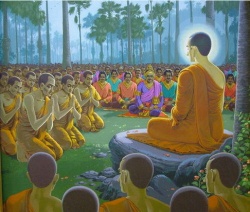Sutras
While Mahayana Buddhism reveres The Tripitaka as a holy text, they add to it a total of 2184 sacred writings. Most of these writings go under the name of Sutra. The Sutras were put into Writing between the second century bce and the second century ce, during the time the split between Theravada and Mahayana developed. Since there are so many new works, different divisions of Mahayana develop in different directions depending on which Sutras they use and emphasize. Just a few, however, are key to much of Mahayana development and Thought.
The most important Sutra is the Lotus Sutra. It depicts a sermon by The Buddha to the assembled Bodhisattvas, Buddhas and other beings in which he teaches the basis of Mahayana Buddhism. He emphasizes the goal of becoming a Bodhisattva, the notion of realizing one's own Buddha-nature, and so on. The Lotus Sutra is used extensively in many forms of Mahayana and Vajrayana Buddhism, and is even the primary text for one strand of Mahayana, Nicheren Buddhism. (You can dip into a chapter of the Lotus Sutra by going here. Or, you can visit a site dedicated to Nicheren here.)
The Heart Sutra also plays an important role in Buddhism. It is short, only a page or two long, but it sets out the character of Nirvana, Emptiness, and Ultimate Reality as perceived within Mahayana. In it, the Bodhisattva Avalokiteshvara describes the nature of the Five Skandhas: Body (=Form), feelings, senses, tendencies, and Consciousness. It is often chanted and discussed, especially in Vajrayana. To read The Heart Sutra, go here or here.
A Sutra called "Land of Bliss" describes the Pure land of Amitabha Buddha. It relates the vow of The Buddha that enabled him to create the Land, and discussed what people must do to enter the Pure land.
The Sutras of the Perfection of Wisdom (Prajna-paramita) provides the basis for Mahayana's understanding of the key notion of "Emptiness." Nagarjuna used this text as a basis for his Thought and writings. The Heart Sutra is part of this larger text.
Sutra is the Sanskrit term used to classify the Mahayana teachings of the Buddha. Most of these were composed in India in Sanskrit and transmitted to China, Korea, Japan, Tibet, and Mongolia where they were translated into the local languages. English translation of many of these sutras may be found on this website by clicking their title on the left or below. Others may be ordered from the Xuanfa Institute Bookstore. A list of some of the major sutras studied at the XFVU is provided below:
Avatamsaka Sutra (The Flower Ornament Scripture): (Ta-fang-kuang-fo-hua-yen-ching or Fo-tuo Ga-ye ):In the mahayana tradition this is considered the First Sermon of the Buddha after His enlightenment. It was taught to Bodhisattvas and celestial beings. Contains the Gandavyuha, Dashabhumika, and Amitayurdhana Sutras.
Expounding the Absolute Truth through the Heart Sutra (English translation of this sutra by H.H. Dorje Chang Buddha III is not yet available)
Diamond Sutra (Essence of the Prajnaparamita Sutras)
Heart Sutra (Essence of the Prajnaparamita Sutras): often chanted in Buddhist temples
Lankavatara Sutra
Mahaparinirvana Sutra: Last sutra taught by the Buddha while He lived in this world, mahayana tradition.
Monk Sutra (English translation of this sutra by H.H. Dorje Chang Buddha III is not yet available, but it is available in Chinese in H.H. Dorje Chang Buddha, A Treasury of True Buddha-Dharma as the exoteric teaching called A Monk Expounds the Absolute Truth to a Layperson.
Prajnaparamita Sutras (Sutra on Perfect Wisdom)
Saddharmapundarika (Lotus) Sutra: (Miao-fa-lien-hua-ching): Primary text of the Tendai and Nicheran sects. Teaches the identification of the historical Buddha with the Transcendental Buddha. Includes the doctrine of “Expedient Means (upaya).
Shurangama Sutra
Sukhavatiyuha (Pure Land) Sutras
Supreme and Unsurpassable Mahamudra of Liberation (English translation of this sutra by H.H. Dorje Chang Buddha III is not yet available, but the chapter on “One Hundred twenty-eight Evil and Erroneous Views” has been published and available on this website.)
Understanding and Realizing Definitive Truth Sutra (English translation of this sutra by H.H. Dorje Chang Buddha III is not yet available, but it is available in Chinese in H.H. Dorje Chang Buddha, A Treasury of True Buddha-Dharma.
Vimalakirti Nirdesa Sutra (The Holy Teachings of Vimalakirti): (Wei-mo-chieh-so-shuo-ching): Famous sutra in which basic mahayana principles are presented as a dialogue between an enlightened layman (ju-shi), Vimalakirti, and famous Buddhist figures. Tibetan Canon. Translations by Charles Luk and Burton Watson from Chinese Canon also available.
Vimalakirti Sutra-Bukkyo Dendo Kyokai (BDK): translation from Chinese.
What Is Cultivation Sutra
Other sutras that are not included on this website, but are of special importance include:
Bhadrakalpika Sutra: The Sutra of 1000 Buddhas.Describes the various Buddhas of our present Fortunate Aeon of which Shakyamuni Buddha is the fourth and Maitreya will be the fifth.
Karandavyuha Sutra or Ornaments of the Basket sutra.Homage to the Bodhisattva Avalokiteshvara.
Karunapundarika Sutra or Sutra of the Lotus of Compassion: About Buddha Padmottara.
Samadhiraja Sutra or Royal Samadhi Sutra: Teaching on emptiness.
Samdhinirmocana Sutra or Wisdom of Buddha: Essential Questions and Direct Answers for Realizing enlightenment. Primary text of the Yogachara School.
Sanghata Sutra or Sutra on the Pair of Monastic Assemblies (Ta ji-hui zheng-fa jing).
Suvarnabhasottama Sutra or The Sutra of Golden Light: Provides guidance for how individuals may direct their actions toward purifying the mind, and generating peace through their practice. Sometimes called the “King of Sutras.”
